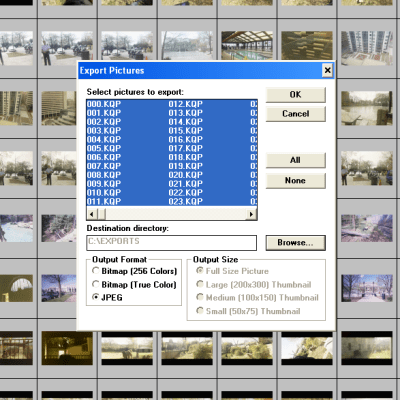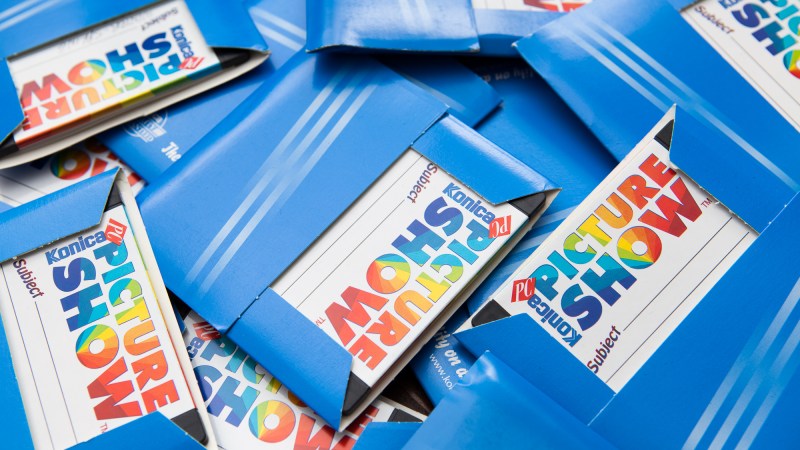[Dave Madison] came across some old digital photos, and in his quest to access them, he ran into quite a few challenges. The saga brings to mind both Murphy’s Law, and while [Dave] prevailed in the end, it required quite a few more steps than one might expect.

Here’s the scene: in the late 90s, Konica partnered with photo shops to provide a photo scanning service, delivering digital scans of film photos on 3.5″ floppy disks, and that’s exactly what [Dave] had to work with. The disks were in good condition, and since modern desktop computers still support floppy drives and the FAT filesystem, in theory all one needs to do is stick disks into the reader one at a time in order to access the photos.
Sadly, problems started early. A floppy drive is revoltingly slow compared to any modern storage device, so [Dave]’s first step was to copy all of the files to his machine’s local storage before working on them. This took a bit of wrangling to deal with 8.3 format file names and avoid naming collisions across disks while still preserving some metadata such as original creation date. It was nothing a quick python script couldn’t handle, but that soon led to the next hurdle.
The photos in question were in an obsolete and proprietary Konica .KQP format. [Dave] went through a number of photo viewing programs that claimed to support .KQP, but none of them actually recognized the images.
Fortunately, each disk contained a copy of Konica’s proprietary “PC PictureShow” viewer, but despite having a variety of versions dated between 1997 and 2001 (making them from the Windows 98 and Windows ME eras) [Dave] could not get any version of the program to run in Windows 10, even with compatibility mode for legacy programs enabled. The solution was to set up a Windows XP virtual machine using Oracle’s Virtualbox, and use that to ultimately run PC PictureShow and finally access the photos. After all that work, [Dave] finally had a stroke of luck: Konica’s software had a handy feature to export images in JPEG format, and it worked like a charm.
In the end, [Dave] was able to save 479 out of the 483 images on the old floppy disks, with a reminder that proprietary formats are a pain. The disks and images may have been over twenty years old, but the roots of digital imaging go considerably further back than that. Take a few minutes out your day to read a bit about Russell Kirsch and the first digitized image, that of his three-month old son in 1957.
















Interesting! Thanks! 👍
Reminds me a bit of Kodak PhotoCD (not PictureCD) and my 286 PC running Windows 3.1.
Back in 1992 or so, you could get your photos back in CD-ROM format.
The CD was in a special format, which required a photo access software by Kodak.
The files themselves were *.pcd files and held the photos in different resolutions.
By the way, judging by the screenshot, the program might be a Win16 program, too! 😎
The window decoration (the visual style or rather the absence of a style) hints that this could be a program running by the help of NTVDM/WoW.
(On Vista+ x86, Aero Glass would mask this old boxy appearance.)
>with a reminder that proprietary formats are a pain
That’s because Konica went through extra trouble to make it so. The KQP format is a BMP file header stuck to a JFIF data blob, so it’s basically a frankensteined JPEG file, except they deliberately broke the data by removing the DQT and DHT tables which are needed to reconstruct the image. These tables are hard coded in the reader program, so no other viewer can open the files unless they have reverse engineered the tables by guesswork.
Are you sure that this wasn’t just a BMP with the compression set to BI_JPEG (decimal 4) and using the default DQT and DHT tables, as they are listed in the JPEG standard? Over the years I’ve had lots of JPEGs that use those tables, including MJPEGs generated from a camera running its default settings: leaving off those tables saved a lot of space!
No. I’m quoting other people who have dealt with the format.
Apparently they used non-standard tables exactly to mess with people’s attempts to decode the files with other software.
The only difference between “proprietary” and “standard” is how much people like it and they all start out as proprietary.
Well there are such things as open standards. For file formats, png comes to mind: conceived as a patent-free gif replacement, and born free. Now, what you’re probably alluding to is that all formats start out uncommon and unpopular, which is true. But with a proper documented open standard, you could conceivably write your own software without reverse engineering, which isn’t the case here with this proprietary format.
Hi! 😃 Speaking of GIF, it was meant as a Graphics Interchange Format.
Akin to Autodesk’s DXF from the CAD corner.
The problem was the compression algorithm used in GIF.
(The patent issue wasn’t CompuServe’s fault.)
The file format itself, uncompressed, could still be used as a means of exchanging picture information accross several platforms (PC, Amiga, Solaris/Unix, etc) .
Sure, it would have been larger.. And maybe less compatible (old GIF viewers expected to decompress). But that didn’t matter for off-line use cases (many GIFs were spread via CD-ROMs in the mid to late 90s).
Also, PNG is still not widely accepted. Some forum software has trouble displaying PNGs.
And it is unnecessarily complicated, not useful for microcontrollers, 8-Bit systems, can’t do transparent animations like GIF etc.
If PNG was just GIF with a different compression algorithm, then maybe it would be more widespread. Unfortunately, development went in the wrong direction. PNG became more sophisticated than users wanted it to be.
People mostly mis-use PNG to upload full high resolution photographs and other complex graphic because “it’s lossless”. This results in higher bandwidth costs and slower server access, and forums that work like it was 1995 again.
This is why I dropped Konica from my vendor space after sveral experiences back in the late 90’s/early 2000’s. EVERYTHING was proprietary, and support consisted of telling you to buy a replacement. Last product was a (then) very expensive, ultra-high res (then) lensless camera (5Mpixel, IIRC). Summary: Software was painful to get to work, non-standard, and the hardware failed in weeks (half dark sensor), and eventually just bought Nikon to get some work done.
No clue if they are better now, or even if they still exist.
“The saga brings to mind both Murphy’s Law”
I’d like to hear more about that.
They were going to discuss both of them, but something went wrong.
Irfanview
Seriously. I use it for media display and for screensharing, its basically Media Player classic for photos.
Maybe it doesn’t do kqp, but its increasingly hard to find simple powerful programs that arent loaded with ads and trial versions and downloaders. So I’m leaving this in case it helps someone.
Irfanview is good and to me a close second to Xnview which I’m using since 2001
Seconded. I’ve been using IrfanView since the mid 90’s. It is the one program I am missing most in Linux.
Xnview is free and has a linux version
ive never tried it, but i like irfanview mainly because (not counting all the plugins i have for it) it fits on a floppy with enough spare space for a few plugins
Just for anyone’s info, I’ve been there and done that. Xnview, which is the only software (with mIRC) I’m still using after 20 years and lots of computers/OS changing, supports KQP and can export to whatever format you’ll need. Heck it’s even freeware (though I donated multiple times throughout the years since it’s very useful) and exists for Windows/Linux (and maybe the whatever OS Apple has these days).
XnView didn’t work for the Op.
Don’t get me started on obsolete, undocumented, proprietary file formats!!!
A big thanks to the people who invented KVM/Qemu and the people who put old software (abandonware) on the internet.
And don’t forget “GraphicConverter” – I’ve been using this tool for three decades now, and it was never unable to open even the most exotic photo-files. Also KQP. No need for abandonware ;-)
https://www.lemkesoft.de/en/products/graphicconverter/download/
Probably could have gotten the old viewer running on otvdm/winevdm.
http://www.columbia.edu/~em36/otvdm.html
Once installed, 16-bit programs get run seamlessly under wine with good compatibility. I’ve used this for running Johnny Castaway & Doonesbury screensavers, Sierra’s Outpost and other games of that era on my modern Windows 10 64-bit system. Many 9x era apps were still 16-bit owing to the large install base of Windows 3.1, and developers who didn’t want to pay for new tools.
Copy photos from 1897, easy as pie, copy photos from 1997, you have to bust your ass. Ah, progress. :)
I think we are finally past all the ‘old’ photo, document, and spreadsheet formats around here. Nothing on floppies any more. Even though I am ‘Windows free’ now, I still keep a XP VM and Win7 VM available in case something comes up. Last thing I remember having to spin up was WordPerfect to get an old file or two converted so LibreOffice would recognize it, which was a few years ago.
Pentax did a similar stunt with their K-x digital SLRs; fortunately, the camera also supports JPG and RAW formats, but their software to manage the images (which included an export feature) kinda sucked, and tended to crash fairly often.
Camera’s decent enough, though…